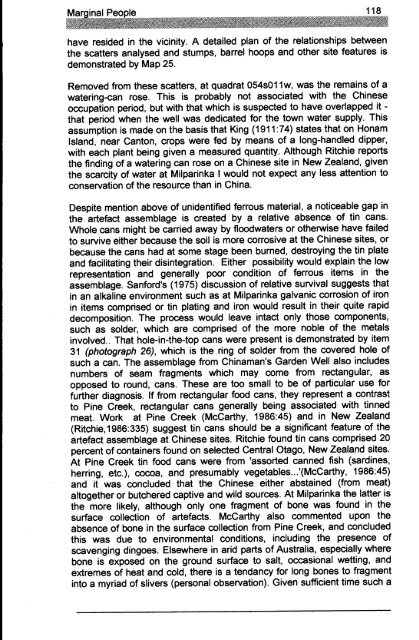Adec Preview Generated PDF File - The Sydney eScholarship ...
Adec Preview Generated PDF File - The Sydney eScholarship ...
Adec Preview Generated PDF File - The Sydney eScholarship ...
Create successful ePaper yourself
Turn your PDF publications into a flip-book with our unique Google optimized e-Paper software.
have resided in the vicinity. A detailed plan of the relationships between<br />
the scatters analysed and stumps, barrel hoops and other site features is<br />
demonstrated by Map 25.<br />
Removed from these scatters, at quadrat 054s011w, was the remains of a<br />
watering-can rose. This is probably not associated with the Chinese<br />
occupation period, but with that which is suspected to have overlapped it <br />
that period when the well was dedicated for the town water supply. This<br />
assumption is made on the basis that King (1911:74) states that on Honam<br />
Island, near Canton, crops were fed by means of a long-handled dipper,<br />
with each plant being given a measured quantity. Although Ritchie reports<br />
the finding of a watering can rose on a Chinese site in New Zealand, given<br />
the scarcity of water at Milparinka I would not expect any less attention to<br />
conservation of the resource than in China.<br />
Despite mention above of unidentified ferrous material, a noticeable gap in<br />
the artefact assemblage is created by a relative absence of tin cans.<br />
Whole cans might be carried away by f100dwaters or otherwise have failed<br />
to survive either because the soil is more corrosive at the Chinese sites, or<br />
because the cans had at some stage been burned, destroying the tin plate<br />
and facilitating their disintegration. Either possibility would explain the low<br />
representation and generally poor condition of ferrous items in the<br />
assemblage. Sanford's (1975) discussion of relative survival suggests that<br />
in an alkaline environment such as at Milparinka galvanic corrosion of iron<br />
in items comprised or tin plating and iron would result in their quite rapid<br />
decomposition. <strong>The</strong> process would leave intact only those components,<br />
such as solder, which are comprised of the more noble of the metals<br />
involved.. That hole-in-the-top cans were present is demonstrated by item<br />
31 (photograph 26), which is the ring of solder from the covered hole of<br />
such a can. <strong>The</strong> assemblage from Chinaman's Garden Well also includes<br />
numbers of seam fragments which may come from rectangular, as<br />
opposed to round, cans. <strong>The</strong>se are too small to be of particular use for<br />
further diagnosis. If from rectangular food cans, they represent a contrast<br />
to Pine Creek, rectangular cans generally being associated with tinned<br />
meat. Work at Pine Creek (McCarthy, 1986:45) and in New Zealand<br />
(Ritchie,1986:335) suggest tin cans should be a significant feature of the<br />
artefact assemblage at Chinese sites. Ritchie found tin cans comprised 20<br />
percent of containers found on selected Central Otago, New Zealand sites.<br />
At Pine Creek tin food cans were from 'assorted canned fish (sardines,<br />
herring, etc.), cocoa, and presumably vegetables...'(McCarthy, 1986:45)<br />
and it was concluded that the Chinese either abstained (from meat)<br />
altogether or butchered captive and wild sources. At Milparinka the latter is<br />
the more likely, although only one fragment of bone was found in the<br />
surface collection of artefacts. McCarthy also commented upon the<br />
absence of bone in the surface collection from Pine Creek, and concluded<br />
this was due to environmental conditions, including the presence of<br />
scavenging dingoes. Elsewhere in arid parts of Australia, especially where<br />
bone is exposed on the ground surface to salt, occasional wetting, and<br />
extremes of heat and cold, there is a tendancy for long bones to fragment<br />
into a myriad of slivers (personal observation). Given sufficient time such a




